We know many of people that say they are die hard whitetail hunters...
But are you really a die hard if you haven't hunted more then just one or two species of whitetail?
How about hunting 14 different species of whitetails all across North and South America??
SCI ( Safari Club International recognizes 14 species of whitetail across the Americas that take you from far South America all the way up into the norther part of North America.
Want to start the journey for all these different subspecies of whitetail?
Here is where you will go and what you will hunt.
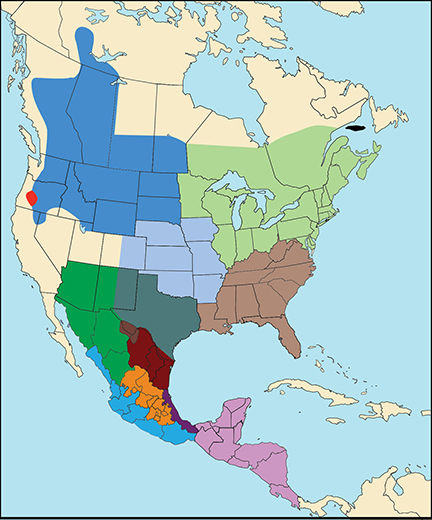
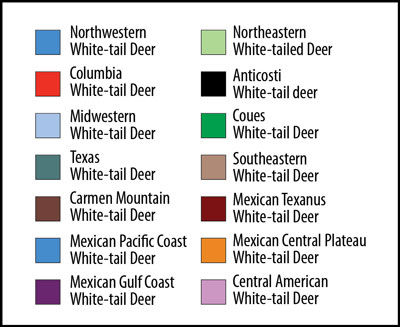
Northwestern Whitetail Deer:
Odocoileus virginianus ssp.
DESCRIPTION A very large whitetail with a relatively pale coat and heavy, widespread antlers.
DISTRIBUTIONCanada: British Columbia, Alberta, Saskatchewan, Manitoba and southwestern Northwest Territories. United States: Washington, Oregon, Idaho, Montana, Wyoming, North and South Dakota, the extreme northeastern corner of California and the northwestern corner of Nevada.
REMARKS Many hunters think the northwestern whitetail grows the largest antlers; however, northeastern whitetail fans are likely to disagree.
TAXONOMIC NOTES The SCI northwestern white-tailed deer category includes all or part of the following subspecies: all of the northwest whitetail (ochrourus), most of the Dakota whitetail (dacotensis) and the South Dakota population of the Kansas whitetail (macrourus).
STATUS Deer within the boundaries of the SCI northwestern whitetail category are plentiful and lawfully huntable except for the Columbia whitetail (leucurus), which was listed as endangered by the USF&WS in 1967. There are two populations: The larger occurs in southwestern Oregon northeast of Roseburg near the North Umpqua River. From fewer than 2,500 in 1981, these deer increased to 5,500 in 1994 and are now causing problems with agricultural damage. A smaller population is found on several islands in the lower Columbia River near Westport, Oregon, and on adjacent mainland areas in Washington and Oregon-largely within the Columbian White-tailed Deer National Wildlife Refuge-where it has been given total protection for many years. This population has grown from fewer than 360 in 1968 to between 800-1,000 in 1994, and is now considered secure. In November 1995, Oregon removed the Columbia whitetail from the state endangered species list and asked the federal government to do the same. This subspecies was also considered endangered by the IUCN at one time, but has since been delisted by that body.
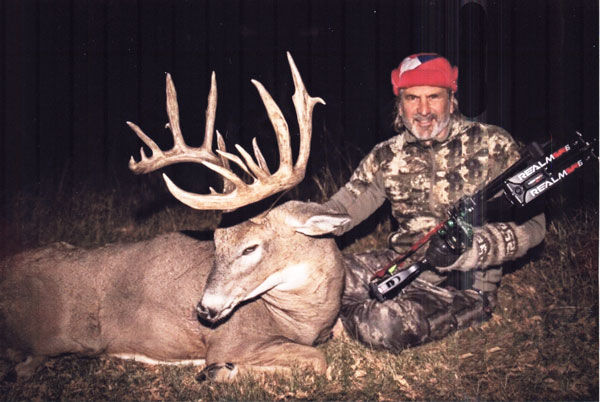
Columbian Whitetail Deer
Odocoileus virginianus leucurus
DESCRIPTION The Columbian White-tailed deer is the western most subspecies of white-tailed deer, which occurs throughout North America. It is 25% to 33% smaller (both males and females) than its geographical neighbor subspecies, the Northwestern White-tailed deer. Only the male deer has antlers, which are shed each winter. New antlers grow in early spring and reach full size in late summer. Breeding activity, referred to as the rutting period, begins the first week of November and lasts a month or more. The females have a gestation period of approximately 210 days, with peak fawning occurring in the mid to late June. Does give birth to one or two fawns with an occasional doe producing triplets. Fawns stay with their mother until just prior to the next fawning season when the doe goes off by herself to give birth to the next generation.
DISTRIBUTION The Columbian White-tailed deer are in two separate populations. The lower Columbian River population is found in Wahkiakum and Cowlitz counties in Washington State and Clatsop, Columbia, and Multnomah counties in Oregon State. The second population is in Douglas County, Oregon in the Umpqua River Basin (see map).
TAXONOMIC NOTES The Columbia White-tailed deer is a member of the Kingdom (Animals), the Phylum (Chordata), the Class (Mammalia), the Order (Artiodactyla), the Family (Cervidae), the Genus (Odocoileus), the Species (Virginianus), the Subspecies (Leucurus). Taxonomical name: Odocoileus virginianus leucurus
STATUS Early records indicate that Columbian White-tailed deer were once quite numerous over its historic range, from the western slopes of the Cascade Mountains to the ocean and from Puget Sound in Washington State southward to the Umpqua River Basin in Southern Oregon. This subspecies of White-tailed deer became endangered throughout its range due to habitat modification by human activities, such as farming and logging, as well as commercial and residential developments. The Columbian White-tailed deer was federally listed as endangered in 1968, at which time the estimated population was thought to be less than 1,000 individuals. A recovery plan was published in 1983. Since then the Douglas County population has rebounded and was delisted in July 2003. The Douglas County population is estimated to be over 5,000 individuals, is self-sustaining in reproduction and the herd is managed by the Oregon Fish and Wildlife Department. Their main management tool is limited hunting.
The lower Columbian River population suffered heavy losses due to extensive flooding of its habitat in 1996. With management and co-operation from Mother Nature, it is expected this herd will be reproductively sustainable in the years to come.
REMARKS The Columbian White-tailed Deer live in two little pockets of the Pacific Northwest. The Umpqua River Basin (Douglas County) is the only place in the world these deer can be hunted.
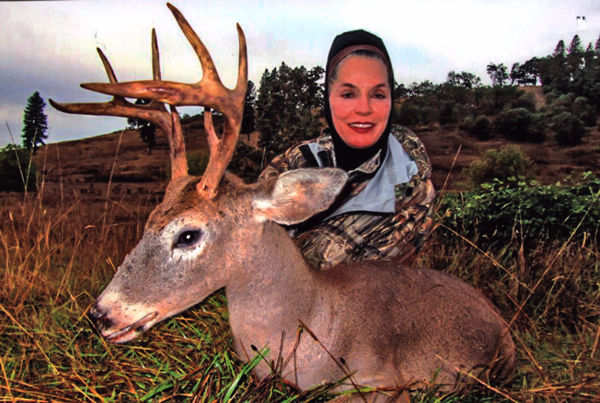
Mid Western Whitetail Deer
Odocoileus virginianus ssp.
Description A very large whitetail with a relatively pale coat and heavy, widespread antlers.
DISTRIBUTION includes Nebraska, Iowa, Missouri, Arkansas, Oklahoma, Kansas and Colorado (all deer taken east of I-25).
TAXONOMIC NOTES The SCI Midwestern white-tailed deer category includes all or part of the following subspecies: northeastern white-tailed, southeastern white-tailed and northwestern white-tailed species.
STATUS Deer within the boundaries of the SCI Midwestern white-tailed category are plentiful and lawfully huntable. Some states are experiencing substantial agricultural and property damage from growing herds. Hunting laws in some Midwestern states now require that white-tailed does are shot prior to taking a whitetail buck. Additional incentives are being offered to hunters in an attempt to better manage herd sizes.

Texas Whitetail Deer
Odocoileus virginianus ssp. DESCRIPTION Texas whitetails have smaller bodies than more northerly specimens. They have slender antlers that often have long tines and good spreads of the main beam. DISTRIBUTION United States: All of Texas and the eastern one-half of New Mexico (specifically east of a line running through Albuquerque and parallel to the eastern state line of New Mexico).
TAXONOMIC NOTES The SCI Texas white-tailed deer category includes the U.S. populations of the Texas whitetail (texanus).
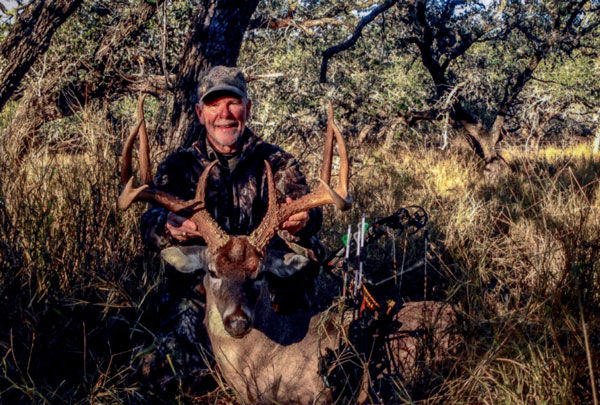
Mexican Pacific Cost Whitetail.
Odocoileus virginianus sinaloae
DESCRIPTION This category groups White tail deer of the following subspecies: O. v. sinaloae, O. v. oaxacensis, O. v. acapulcensis, O. v. toltecus, O. v. nelsoni y O. v. thomasi, which are deer of medium size and with small antler growth, with small mass, width and small tines growth. Principal measurements for largest male (Taylor, 1956) are: total length 55 in. (139 cm); tail 7.5 in. (19 cm); height at shoulder 29 in. (73 cm).
DISTRIBUTION The main area of distribution includes the states of Sinaloa, Nayarit, Colima, Guerrero, Oaxaca and Chiapas states/
Jalisco state municipalities of: Acatic, Amatitlán, Arandas, El Arenal, Atotonilco el Alto, Ayotlán, La Barca, Bolaños, Colotlán, Cuquio, Chapala, Chimaltitán, Degollado, Encarnación de Díaz, Guadalajara, Huejúcar, Huejuquilla el Alto, Ixtlahuacán de los Membrillos, Ixtlahuacán del Río, Jalostotitlán, Jamay, Jesús María, Juanacatlán, Lagos de Moreno, Mexticacán, Mezquitic, Ocotlán, Ojuelos de Jalisco, Poncitlán, El Salto, San Cristóbal de la Barranca, San Diego de Alejandría, San Juan de los Lagos, San Julián, San Martín de Bolaños, San Miguel el Alto, Santa María de los Ángeles, Tala, Teocaltiche, Tepatitlán de Morelos, Tequila, Tlajomulco de Zúñiga, Tlaquepaque, Tonalá, Totatiche, Tototlán, Unión de San Antonio, Valle de Guadalupe, Villa Guerrero, Villa Hidalgo, Cañadas de Obregón, Yahualica de González Gallo, Zapopán and Zapotlán del Rey.
Michoacán state municipalities of: Aguililla, Apatzingán, Aquila, Ario, Arteaga, Buenavista, Carácuaro, Coahuayana, Coalcomán de Vázquez Pallares, Chinicuila, Churumuco, Gabriel Zamora, La Huacana, Huetamo, Juárez, Jungapeo, Madero, Lázaro Cárdenas, Múgica, Nocupétaro, Nuevo Parangaricutiro, Nuevo Urecho, Ocampo, Parácuaro, Peribán, San Lucas, Salvador Escalante, Susupuato, Tacámbaro, Tancítaro, Taretan, Tepalcatepec, Tingambato, Tiquicheo de Nicolás Romero, Tumbiscatío, Turicato, Tuxpan, Tuzantla, Uruapan, Ziracuaretiro and Zitácuaro.
HABITAT The natural habitat is thorn forest, tropical deciduous forest, oak and conifur forest and tropical rain forest. Dominant weather is hot and template tropical.
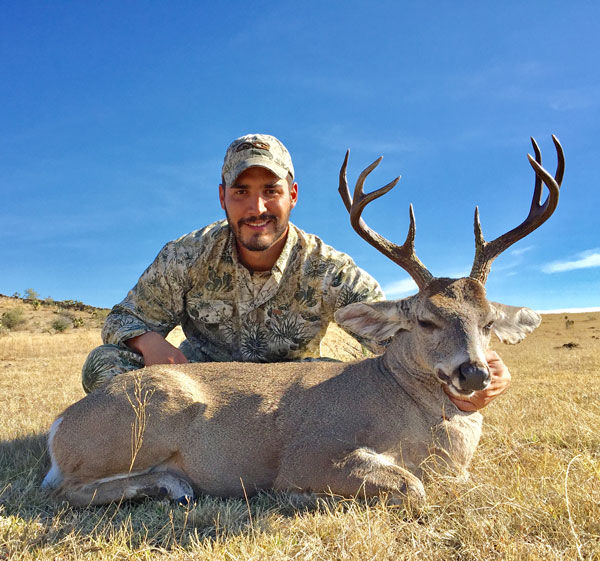
Mexican Gulf Coast Whitetail
Odocoileus virginianus veraecrucis
DESCRIPTION This category groups White tail deer of the following subspecies: O. v. veraecrucis, O. v. thomasi, O. v. truei y O. v. yucatanensis, which are deer of médium size and with small antler growth, with small mass, width and small tines growth. Principal measurements for largest male (Taylor, 1956) are: total length 58 in. (148 cm); tail 7 in. (18 cm); height at shoulder 30 in. (76 cm).
DISTRIBUTION The main area of distribution is Veracruz, Tabasco, Campeche, Yucatán and Quintana Roo states, and Tamaulipas state municipalities of: Abasolo, Aldama, Altamira, Antiguo Morelos, Burgos, Bustamante, Casas, Ciudad Cruillas, Matamoros, Méndez, Madero, Gómez Farías, González, Güémez, Hidalgo, Jaumave, Jiménez, Llera, Maimero, El Mante, Miquihuana, Nuevo Morelos, Ocampo, Padilla, Palmillas, Río Bravo, San Carlos, San Fernando, San Nicolás, Soto La Marina, Tampico, Tula, Valle Hermoso, Victoria, Villagrán and Xicotencatl.
HABITAT The natural habitat is thorn forest, tropical deciduous forest and tropical rain forest. The dominate weather is tropical wet-warm.

Northeastern Whitetaildeer
Odocoileus virginianus ssp.
DESCRIPTION The largest whitetail in body size. The antlers are usually heavy.
DISTRIBUTIONCanada: Southern Ontario, southern Quebec and the maritime provinces. United States: Minnesota, Wisconsin, Michigan, Illinois, Indiana, Ohio, Pennsylvania, Maryland, Delaware, New Jersey, New York and the New England states.
REMARKS The northeastern whitetail is the most popular big game animal in North America-most numerous, most heavily hunted, and most deer taken. In many states, it is the only big game animal available on the license. Many hunters believe the northeastern whitetail can produce the best antlers of all.
TAXONOMIC NOTES The SCI northeastern white-tailed deer category includes all or part of the following subspecies: all of the northern woodland whitetail (borealis); and the Minnesota population of the Dakota whitetail (dacotensis).

Anticosti Whitetail Deer
Odocoileus virginianus ssp.
DESCRIPTION a moderate sized whitetail with bucks weighing up to 150 pounds. The deer have a relatively pale coat with hollow hair and smaller antlers than their northern cousins.
DISTRIBUTION consists of the (equivalent 3,000-square-mile) Anticosti Island. The Island is larger than Delaware and Rhode Island combined.
STATUS The island of Anticosti is owned by Quebec and has no game species that are native to the island. In the early 1890s, a French candy baron, Henri Menier, purchased the island and established a great private hunting preserve. Between the years of 1895 and 1920, Henri introduced wildlife including elk, moose, caribou, snowshoe hare, mink, grouse, red fox, frogs, beaver, buffalo and whitetail. The whitetail has prospered on the harsh but fertile island. The only predator of the Anticosti whitetail is the harsh winter. The herds have grown to more than 66,000 deer with a density of twenty deer per square mile.

Coues Whitetail Deer
Odocoileus virginianus couesi Venado cola blanca de Coues (Sp). Named in honor of Dr. Elliott Coues, naturalist and former U.S. Army physician. Also called Arizona whitetail, fantail, and sometimes dwarf whitetail. DESCRIPTION One of the smaller whitetails, with shoulder height of 32-34 inches (81-86 cm) and weight of about 100 pounds (45 kg). Ears and tail are disproportionately long for the body size. The coloration is lighter, as is usual in desert animals, varying from fawn in summer to grayish in winter. Mature bucks normally have four points to a side including the brow tines. HABITAT Desert regions, especially hills and mountains between 4,000-8,000 feet (1,200-2,400 m) elevation, usually with scrub oak and high grassy basins. DISTRIBUTION This subspecies is isolated from other whitetails in most of the United States, but comes into contact with other whitetails in Mexico and New Mexico. United States: Arizona and the western one-half of New Mexico (specifically west of a line running through Albuquerque and parallel to the western state line of New Mexico.)
Mexico: Sonora and Durango states, and Chihuahua state municipalities of: Allende, Aquiles Serdán, Ascención, Bachiniva, Balleza, Batopilas, Bocoyna, Buenaventura, Carichi, Casas Grandes, Coronado, Cuauhtémoc, Cusihuiriachi, Chinipas, Dr. Belisario Domínguez, Galeana, Santa Isabel, Gómez Farías, Gran Morelos, Guachochi, Guadalupe y Calvo, Guazapares, Guerrero, Huejotitan, Ignacio Zaragoza, Janos, Madera, Mahuarichi, Matachi, Matamoros, Morelos, Moris, Namiquipa, Nonoava, Nuevo Casas Grandes, Ocampo, Riva Palacio, Rosario, San Francisco de Borja, San Francisco del Oro, Santa Bárbara, Satevó, Temosachi, El Tule, Urique, Uruachi and Valle de Zaragoza.

Southeastern Whitetail Deer
Odocoileus virginianus ssp.
DESCRIPTION A moderately large whitetail in body size, but smaller than the Northeastern or Northwestern white-tailed Deer. Has fairly heavy, though often short, antlers.
DISTRIBUTION Virginia, West Virginia, Kentucky, Tennessee, North and South Carolina, Georgia, Alabama, Mississippi, Louisiana and Florida.
REMARKS Few antlers from this region will score as well as those from the Northeast or Northwest.
TAXONOMIC NOTES The SCI southeastern white-tailed deer category includes the following subspecies: Virginia whitetail (virginianus), Florida whitetail (seminolus), Florida coastal whitetail (osceola), Blackbeard Island whitetail (nigribarbis), Hilton Head whitetail (hiltonensis), Hunting Island whitetail (venatorius) and Bull's Island whitetail (taurinsulae). It also includes the Louisiana population of the Avery Island whitetail (mcilhennyi) and the Louisiana and populations of the Kansas whitetail (macrourus).
STATUS The key, or toy, white-tailed deer (clavium) of the western Florida Keys was once near extinction but is now secure on its refuge and protected by law. It is considered out of danger by the IUCN, but is still (since 1967) listed as endangered.

Mexican Texanus White-tailed Deer
Odocoileus virginianus texanus
DESCRIPTION This category includes White tail deer (Odocoileus virginianus) of the O. v. texanus subspecies: These are the biggest size, body weight and antler development deer, in Mexico. Principal measurements for largest male (Taylor, 1956) are: total length, 72 in. (183 cm); tail 10in. (25 cm); height at shoulder 41in. (105 cm).
DISTRIBUTION AND HABITAT The main area of distribution of the subspecies is the North-East part of the state of Coahuila; North and North-East of Nuevo León; North and North-East of Tamaulipas and North-East of Chihuahua. The natural habitat is xeric scrub and thorn scrub of extreme dry weather.
MEXICO: Chihuahua state municipalities of: Ahumada, Aldama, Coyame del Sotol, Chihuahua, Delicias, Guadalupe, Hidalgo del Parral, Juárez, Julimes, Meoqui, Praxedis G. Guerrero and Rosales. Coahuila state municipalities of: Abasolo, Acuña, Allende, Candela, Escobedo, Frontera, Guerrero, Hidalgo, Jiménez, Juárez, Monclova, Morelos, Nava, Piedras Negras, Progreso, Sabinas, Sacarmento, San Juan de Sabinas, Villa Unión and Zaragoza. Nuevo León state municipalities of: Abasolo, Agualeguas, Los Aldamas, Anáhuac, Apodaca, Bustamante, Cadereyta Jiménez, Carmen, Cerralvo, Ciénega de Flores, China, Dr. Coss, General Bravo, General Escobedo, General Terán, General Treviño, General Zuazua, Guadalupe, Los Herreras, Higueras, Lampazos de Naranjo, Linares, Melchor Ocampo, Marín, Mina, Monterrey, Parás, Pesquería, Los Ramones, Sabinas Hidalgo, Salinas Victoria, San Nicolás de los Garza, Hidalgo, Vallecillo and Villaldama. Tamaulipas state municipalities of: Camargo, Guerrero, Gustavo Díaz Ordaz, Mier, Miguel Alemán, Nuevo Laredo and Reynosa.
HABITAT The natural haibitat is xeric scrub and thorn scrub of extreme dry weather.

Mexican Central Plateau White-tailed Deer
Odocoileus virginianus miquihuaneusis
DESCRIPTION This category groups White tail deer of the following subspecies: O. v. miquihuanensis and O. v. mexicanus, which are deer with size, body weight and antler scores smaller than the Mexican Texanus WTD; but bigger in size, body weight and antler scores smaller than the Mexican Gulf Coast WTD and Mexican Pacific Coast WTD. Principal measurements for largest male (Taylor, 1956) are: total length 60 in. (154 cm); tail 10 in. (25 cm); height at shoulder 34 in. (87 cm).
DISTRIBUTION MEXICO: Aguascalientes, Guanajuato, Hidalgo, México, Morelos, Puebla, Querétaro, San Luis Potosí, Tlaxcala and Zacatecas states. Coahuila state municipalities of: Arteaga, Castaños, Cuatro Ciénegas, Francisco I. Madero, General Cepeda, Matamoros, Parras, Ramos Arizpe, Saltillo, San Pedro, Torreón and Viesca. Nuevo León state municipalities of: Allende, Aramberri, Dr. Arroyo, Dr. González, Galeana, García, Hualahuises, San Pedro Garza García, General Zaragoza, Iturbide, Juárez, Montemorelos, Mier y Noriega, Rayones, Santa Catarina and Santiago. Jalisco state municipalities of: Acatlán de Juárez, Ahualulco de Mercado, Amacueca, Ameca, San Juanito de Escobedo, Atemajac de Brizuela, Atengo, Atenguillo, Atoyac, Autlán de Navarro, Ayutla, Cabo Corrientes, Casimiro Castillo, Cihuatlán, Zapotlán el Grande, Cocula, Concepción de Buenos Aires, Cuautitlán de García Barragán, Cuautla, Chiquilistlán, Ejutla, Etzatlán, El Grullo, Guachinango, Hostotipaquillo, La Huerta, Jilotlán de los Dolores, Jocotepec, Juchitlán, El Limón, Magdalena, Santa María del Oro, La Manzanilla de la Paz, Mascota, Mazamitla, Mixtlán, Pihuamo, Puerto Vallarta, Villa Purificación, Cuitupan, San Marcos, San Martín Hidalgo, Gómez Farías, San Sebastián del Oeste, Sayula, Talpa de Allende, Tamazula de Gordiano, Tapalpa, Tecalitlán, Tecolotlán, Techaluta de Montenegro, Tenamaxtlán, Teocutatlán de Corona, Teuchitlán, Tizapán el Alto, Tolimán, Tomatlán, Tonaya, Tonila, Tuxcacuesco, Tuxcueca, Tuxpan, Unión de Tula, Valle de Juárez, San Gabriel, Villa Corona, Zacoalco de Torres, Zapotiltic, Zapotitlán de Vadillo and Zapotlanejo. Michoacán state municipalities of: Acuitzio, Álvaro Obregón, Angamacutiro, Angangueo, Aporo, Briseñas, Coeneo, Contepec, Copándaro, Cotija, Cuitzeo, Charapan, Charo, Chavinda, Cherán, Chilchota, Chucándiro, Churintzio, Ecuandureo, Epitacio Huerta, Erongaricuaro, Hidalgo, Huandacareo, Huaniqueo, Huiramba, Indaparapeo, Irimbo, Ixtlán, Jacona, Jiménez, Jiquilpan, Lagunillas, Maravatío, Marcos Castellanos, Morelia, Morelos, Nahuatzen, Numarán, Pajacuarán, Panindicuaro, Paracho, Pátzcuaro, Penjamillo, La Piedad, Purépero, Puruándiro, Queréndaro, Quiroga, Cojumatlán de Régules, Los Reyes, Sahuayo, Santa Ana Maya, Senguio, Tangamandapio, Tangancicuaro, Tanhuato, Tarímbaro, Tingüindin, Tlalpujahua, Tlazazalca, Tocumbo, Tzintzuntzan, Tzitzio, Venustiano Carranza, Villamar, Vista Hermosa, Yurécuaro, Zacapu, Zamora, Zináparo, Zinapécuaro and José Sixto Verduzco HABITAT: The natural habitat is xeric scrub and thorn scrub of extreme dry weather in the northern area and template weather in the sourthern area.

Central American White-tailed Deer
Odocoileus virginianus yucatanensis Also called tropical white-tailed deer. TAXONOMIC NOTES The Central American whitetail category consists of the Yucatán whitetail (yucatanensis), Chiapas whitetail (nelsoni), Nicaragua whitetail (truei), Panama whitetail (chiriquensis), Coiba Island whitetail (rothschildi), the lowland Mexican whitetail (thomasi). The name yucatanensis Hays, 1872 has priority. DESCRIPTION These are the smallest North American whitetails, with mature bucks usually weighing less than 100 pounds (45 kg)-sometimes much less. Antlers are short, slim, and compact, with the main beams usually growing backward in the plane of the face and the tips curving inward and a little forward. There are usually three points on a side, including brow tines, but sometimes two or four. Brow tines are often relatively long. The lowland Mexican whitetail (thomasi) is a relatively large race that is more brightly colored than other Mexican and Central American whitetails. General color is bright tawny, with a grizzled golden tint in winter when the coat is longer. Tail is bright tawny on top. Forehead is black, or black and tawny. Usually three antler points to a side, including a brow tine. Found in the Mexican states of Tabasco, Campeche, and Chiapas; and northwestern and southwestern Guatemala.
The Yucatán whitetail (yucatanensis) has a shoulder height of 25-26 inches (64-66 cm). The coat is paler and less tawny than in the lowland and Nicaragua races. Antlers are relatively straight and simple, with few tines. Found in Mexico in Campeche, Yucatán, and Quintana Roo. The Chiapas whitetail (nelsoni) is a small race, 25-26 inches (64-66 cm) at the shoulder, with the general coloration brownish-gray. Tail is tawny on the upper surface, dorsal stripe and crown are blackish, ears are grizzled gray. Small metatarsal glands are present. Antlers are small. Found in the high mountains of central Chiapas in Mexico, and in El Salvador, southern Honduras, and western Nicaragua. The Nicaragua whitetail (truei) is larger than the two preceding races, with shoulder height of about 32 inches (81 cm). Summer coat is bright chestnut, turning a speckled brownish-gray in winter. Tail is tawny on the upper surface, ears are gray with a large white spot at the base, forehead is dark, and a dusky-brown facial streak extends to the nose. There is a small metatarsal gland. Antlers are small, with 3-4 tines to a side, including relatively long brow tines. Found in southern Quintana Roo and Campeche in Mexico, and in Belize, Guatemala, Honduras, most of Nicaragua, and Costa Rica. The Panama whitetail (chiriquensis) occurs in Panama, but we have no other information. The Coiba Island whitetail (rothschildi) is a very small deer with a generally brown coat, the hairs tipped with fawn, and a darker dorsal line. Tail is fawn-colored on top, with a black tip. No metatarsal glands. Antlers are short, with 2-3 points on a side. Found on Coiba Island, off the Pacific coast of Panama. DISTRIBUTION Mexico: Tabasco, Chiapas, Campeche, Yucatán and Quintana Roo. Central America: Guatemala, Belize, El Salvador, Honduras, Nicaragua, Costa Rica and Panama (west and north of the Panama canal).

If you think your a whitetail nut we challenge you to pursue all of these species of whitetail found in North and South America.
Good luck to you all this coming hunting season!

Comentários